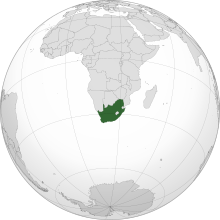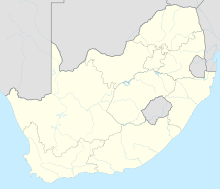
A | B | C | D | E | F | G | H | CH | I | J | K | L | M | N | O | P | Q | R | S | T | U | V | W | X | Y | Z | 0 | 1 | 2 | 3 | 4 | 5 | 6 | 7 | 8 | 9
Republic of South Africa 10 other official names[1]
| |||||||||||||||||||||
|---|---|---|---|---|---|---|---|---|---|---|---|---|---|---|---|---|---|---|---|---|---|
| Motto: "ǃke e: ǀxarra ǁke" (ǀXam) "Unity in diversity" | |||||||||||||||||||||
| Anthem: "National anthem of South Africa" | |||||||||||||||||||||
| Capital | |||||||||||||||||||||
| Largest city | Johannesburg[3] | ||||||||||||||||||||
| Official languages | 12 languages[1][4]
Languages with special status[5] | ||||||||||||||||||||
| Ethnic groups (2022[6]) | |||||||||||||||||||||
| Religion (2016)[7] |
| ||||||||||||||||||||
| Demonym(s) | |||||||||||||||||||||
| Government | Unitary parliamentary republic with an executive presidency | ||||||||||||||||||||
| Cyril Ramaphosa | |||||||||||||||||||||
| Paul Mashatile | |||||||||||||||||||||
| Amos Masondo | |||||||||||||||||||||
| Vacant | |||||||||||||||||||||
| Raymond Zondo | |||||||||||||||||||||
| Legislature | Parliament | ||||||||||||||||||||
| National Council | |||||||||||||||||||||
| National Assembly | |||||||||||||||||||||
| Independence from the United Kingdom | |||||||||||||||||||||
• Union | 31 May 1910 | ||||||||||||||||||||
| 11 December 1931 | |||||||||||||||||||||
• Republic | 31 May 1961 | ||||||||||||||||||||
| 4 February 1997 | |||||||||||||||||||||
| Area | |||||||||||||||||||||
• Total | 1,221,037 km2 (471,445 sq mi) (24th) | ||||||||||||||||||||
• Water (%) | 0.380 | ||||||||||||||||||||
| Population | |||||||||||||||||||||
• 2022 census | 62,027,503[8] (23rd) | ||||||||||||||||||||
• Density | 50.8/km2 (131.6/sq mi) (169th) | ||||||||||||||||||||
| GDP (PPP) | 2024 estimate | ||||||||||||||||||||
• Total | |||||||||||||||||||||
• Per capita | |||||||||||||||||||||
| GDP (nominal) | 2024 estimate | ||||||||||||||||||||
• Total | |||||||||||||||||||||
• Per capita | |||||||||||||||||||||
| Gini (2014) | very high | ||||||||||||||||||||
| HDI (2022) | high (110th) | ||||||||||||||||||||
| Currency | South African rand (ZAR) | ||||||||||||||||||||
| Time zone | UTC+2 (SAST) | ||||||||||||||||||||
| Date format | Short formats: | ||||||||||||||||||||
| Driving side | left | ||||||||||||||||||||
| Calling code | +27 | ||||||||||||||||||||
| ISO 3166 code | ZA | ||||||||||||||||||||
| Internet TLD | .za | ||||||||||||||||||||
South Africa, officially the Republic of South Africa (RSA or R.S.A.), is the southernmost country in Africa. It is bounded to the south by 2,798 kilometres (1,739 mi) of coastline that stretches along the South Atlantic and Indian Oceans;[17][18][19] to the north by the neighbouring countries of Namibia, Botswana, and Zimbabwe; and to the east and northeast by Mozambique and Eswatini. It also completely enclaves Lesotho.[20] It is the southernmost country on the mainland of the Old World, and the second-most populous country located entirely south of the equator, after Tanzania. South Africa is a biodiversity hotspot, with unique biomes, plant and animal life. With over 62 million people, the country is the world's 23rd-most populous nation and covers an area of 1,221,037 square kilometres (471,445 square miles). Pretoria is the administrative capital, while Cape Town, as the seat of Parliament, is the legislative capital. Bloemfontein has traditionally been regarded as the judicial capital.[21] The Constitutional Court, the country's highest court, is located in Johannesburg.
About 80% of the population are Black South Africans.[6] The remaining population consists of Africa's largest communities of European (White South Africans), Asian (Indian South Africans and Chinese South Africans), and multiracial (Coloured South Africans) ancestry. South Africa is a multiethnic society encompassing a wide variety of cultures, languages, and religions. Its pluralistic makeup is reflected in the constitution's recognition of 12 official languages, the fourth-highest number in the world.[19] According to the 2011 census, the two most spoken first languages are Zulu (22.7%) and Xhosa (16.0%).[22] The next two are of European origin: Afrikaans (13.5%) developed from Dutch and serves as the first language of most Coloured and White South Africans; English (9.6%) is commonly used in public and commercial life, both reflecting the legacy of Dutch and British colonialism, respectively.
Regular elections have been held for almost a century in the country. However, the vast majority of Black South Africans were not enfranchised until 1994. During the 20th century, the black majority sought to claim more rights from the dominant white minority, which played a large role in the country's recent history and politics. The National Party imposed apartheid in 1948, institutionalising previous racial segregation. After a largely non-violent struggle by the African National Congress and other anti-apartheid activists both inside and outside the country, the repeal of discriminatory laws began in the mid-1980s. Since 1994, all ethnic and linguistic groups have held political representation in the country's liberal democracy, which comprises a parliamentary republic and nine provinces. South Africa is often referred to as the "rainbow nation" to describe the country's multicultural diversity, especially in the wake of apartheid.[23] According to the 2023 V-Dem Democracy indices, South Africa is ranked the 51st electoral democracy worldwide and the 3rd electoral democracy in Africa.[24]
South Africa is a middle power in international affairs; it maintains significant regional influence and is a member of both the Commonwealth of Nations and the G20.[25][26] It is a developing country, ranking 109th on the Human Development Index, the 7th highest on the continent. South Africa is the only African nation to legislate same-sex marriage.[27] It has been classified by the World Bank as a newly industrialised country and has the largest and most industrialised, technologically advanced economy in Africa overall,[28] as well as the 38th-largest economy in the world.[29][30] South Africa has the most UNESCO World Heritage Sites in Africa. Since the end of apartheid, government accountability and quality of life have substantially improved.[31] However, crime, poverty, and inequality remain widespread, with about 40% of the total population being unemployed as of 2021[update],[32] while some 60% of the population lived below the poverty line and a quarter lived below $2.15 a day.[33][34][35] Having the highest Gini coefficient of 63.0, South Africa is considered to be one of, if not the most, unequal countries in the world.[36][37]
Etymology
The name "South Africa" is derived from the country's geographic location at the southern tip of Africa. Upon formation, the country was named the Union of South Africa in English and Unie van Zuid-Afrika in Dutch, reflecting its origin from the unification of four British colonies. Since 1961, the long formal name in English has been the "Republic of South Africa" and Republiek van Suid-Afrika in Afrikaans. The country has an official name in 12 official languages.[38][39]
Mzansi, derived from the Xhosa noun uMzantsi meaning "south", is a colloquial name for South Africa,[40][41] while some Pan-Africanist political parties prefer the term "Azania".[42]
History
Prehistoric archaeology

South Africa contains some of the oldest archaeological and human-fossil sites in the world.[43][44][45] Archaeologists have recovered extensive fossil remains from a series of caves in Gauteng Province. The area, a UNESCO World Heritage Site, has been branded "the Cradle of Humankind". The sites include Sterkfontein, one of the richest sites for hominin fossils in the world, as well as Swartkrans, Gondolin Cave, Kromdraai, Cooper's Cave and Malapa. Raymond Dart identified the first hominin fossil discovered in Africa, the Taung Child (found near Taung) in 1924. Other hominin remains have come from the sites of Makapansgat in Limpopo Province; Cornelia and Florisbad in Free State Province; Border Cave in KwaZulu-Natal Province; Klasies River Caves in Eastern Cape Province; and Pinnacle Point, Elandsfontein and Die Kelders Cave in Western Cape Province.[46]
These finds suggest that various hominid species existed in South Africa from about three million years ago, starting with Australopithecus africanus,[47] followed by Australopithecus sediba, Homo ergaster, Homo erectus, Homo rhodesiensis, Homo helmei, Homo naledi and modern humans (Homo sapiens). Modern humans have inhabited Southern Africa for at least 170,000 years. Various researchers have located pebble tools within the Vaal River valley.[48][49]
Bantu expansion
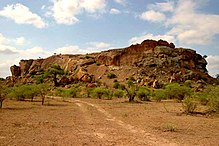
Settlements of Bantu-speaking peoples, who were iron-using agriculturists and herdsmen, were present south of the Limpopo River (now the northern border with Botswana and Zimbabwe) by the 4th or 5th century CE. They displaced, conquered, and absorbed the original Khoisan, Khoikhoi and San peoples. The Bantu slowly moved south. The earliest ironworks in modern-day KwaZulu-Natal Province are believed to date from around 1050. The southernmost group was the Xhosa people, whose language incorporates certain linguistic traits from the earlier Khoisan people. The Xhosa reached the Great Fish River, in today's Eastern Cape Province. As they migrated, these larger Iron Age populations displaced or assimilated earlier peoples. In Mpumalanga Province, several stone circles have been found along with a stone arrangement that has been named Adam's Calendar, and the ruins are thought to be created by the Bakone, a Northern Sotho people.[50][51]
Portuguese exploration
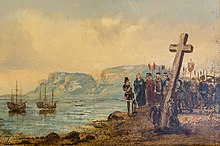
In 1487, the Portuguese explorer Bartolomeu Dias led the first European voyage to land in southern Africa.[52] On 4 December, he landed at Walfisch Bay (now known as Walvis Bay in present-day Namibia). This was south of the furthest point reached in 1485 by his predecessor, the Portuguese navigator Diogo Cão (Cape Cross, north of the bay). Dias continued down the western coast of southern Africa. After 8 January 1488, prevented by storms from proceeding along the coast, he sailed out of sight of land and passed the southernmost point of Africa without seeing it. He reached as far up the eastern coast of Africa as, what he called, Rio do Infante, probably the present-day Groot River, in May 1488. On his return he saw the cape, which he named Cabo das Tormentas ('Cape of Storms'). King John II renamed the point Cabo da Boa Esperança, or Cape of Good Hope, as it led to the riches of the East Indies.[53] Dias' feat of navigation was immortalised in Luís de Camões' 1572 epic poem Os Lusíadas.
Dutch colonisation

By the early 17th century, Portugal's maritime power was starting to decline, and English and Dutch merchants competed to oust Portugal from its lucrative monopoly on the spice trade.[54] Representatives of the British East India Company sporadically called at the cape in search of provisions as early as 1601 but later came to favour Ascension Island and Saint Helena as alternative ports of refuge.[55] Dutch interest was aroused after 1647, when two employees of the Dutch East India Company were shipwrecked at the cape for several months. The sailors were able to survive by obtaining fresh water and meat from the natives.[55] They also sowed vegetables in the fertile soil.[56] Upon their return to Holland, they reported favourably on the cape's potential as a "warehouse and garden" for provisions to stock passing ships for long voyages.[55]
In 1652, a century and a half after the discovery of the cape sea route, Jan van Riebeeck established a victualling station at the Cape of Good Hope, at what would become Cape Town, on behalf of the Dutch East India Company.[57][58] In time, the cape became home to a large population of vrijlieden, also known as vrijburgers (lit. 'free citizens'), former company employees who stayed in Dutch territories overseas after serving their contracts.[58] Dutch traders also brought thousands of enslaved people to the fledgling colony from Indonesia, Madagascar, and parts of eastern Africa.[59] Some of the earliest mixed race communities in the country were formed between vrijburgers, enslaved people, and indigenous peoples.[60] This led to the development of a new ethnic group, the Cape Coloureds, most of whom adopted the Dutch language and Christian faith.[60]
The eastward expansion of Dutch colonists ushered in a series of wars with the southwesterly migrating Xhosa tribe, known as the Xhosa Wars, as both sides competed for the pastureland near the Great Fish River, which the colonists desired for grazing cattle.[61] Vrijburgers who became independent farmers on the frontier were known as Boers, with some adopting semi-nomadic lifestyles being denoted as trekboers.[61] The Boers formed loose militias, which they termed commandos, and forged alliances with Khoisan peoples to repel Xhosa raids.[61] Both sides launched bloody but inconclusive offensives, and sporadic violence, often accompanied by livestock theft, remained common for several decades.[61]
British colonisation and the Great Trek
Great Britain occupied Cape Town between 1795 and 1803 to prevent it from falling under the control of the French First Republic, which had invaded the Low Countries.[61] After briefly returning to Dutch rule under the Batavian Republic in 1803, the cape was occupied again by the British in 1806.[62] Following the end of the Napoleonic Wars, it was formally ceded to Great Britain and became an integral part of the British Empire.[63] British emigration to South Africa began around 1818, subsequently culminating in the arrival of the 1820 Settlers.[63] The new colonists were induced to settle for a variety of reasons, namely to increase the size of the European workforce and to bolster frontier regions against Xhosa incursions.[63]

In the first two decades of the 19th century, the Zulu people grew in power and expanded their territory under their leader, Shaka.[64] Shaka's warfare indirectly led to the Mfecane ('crushing'), in which one to two million people were killed and the inland plateau was devastated and depopulated in the early 1820s.[65][66] An offshoot of the Zulu, the Matabele people created a larger empire that included large parts of the highveld under their king Mzilikazi.
During the early 19th century, many Dutch settlers departed from the Cape Colony, where they had been subjected to British control, in a series of migrant groups who came to be known as Voortrekkers, meaning "pathfinders" or "pioneers". They migrated to the future Natal, Free State, and Transvaal regions. The Boers founded the Boer republics: the South African Republic, the Natalia Republic, and the Orange Free State.[67]
The discovery of diamonds in 1867 and gold in 1884 in the interior started the Mineral Revolution and increased economic growth and immigration. This intensified British subjugation of the indigenous people. The struggle to control these important economic resources was a factor in relations between Europeans and the indigenous population and also between the Boers and the British.[68]

On 16 May 1876, President Thomas François Burgers of the South African Republic declared war against the Pedi people. King Sekhukhune managed to defeat the army on 1 August 1876. Another attack by the Lydenburg Volunteer Corps was also repulsed. On 16 February 1877, the two parties signed a peace treaty at Botshabelo.[69] The Boers' inability to subdue the Pedi led to the departure of Burgers in favour of Paul Kruger and the British annexation of the South African Republic. In 1878 and 1879 three British attacks were successfully repelled until Garnet Wolseley defeated Sekhukhune in November 1879 with an army of 2,000 British soldiers, Boers and 10,000 Swazis.
The Anglo-Zulu War was fought in 1879 between the British and the Zulu Kingdom. Following Lord Carnarvon's successful introduction of federation in Canada, it was thought that similar political effort, coupled with military campaigns, might succeed with the African kingdoms, tribal areas and Boer republics in South Africa. In 1874, Henry Bartle Frere was sent to South Africa as the British High Commissioner to bring such plans into being. Among the obstacles were the presence of the independent states of the Boers, and the Zululand army. The Zulu nation defeated the British at the Battle of Isandlwana. Eventually Zululand lost the war, resulting in the termination of the Zulu nation's independence.[70]
Boer Wars


The Boer republics successfully resisted British encroachments during the First Boer War (1880–1881) using guerrilla warfare tactics, which were well-suited to local conditions. The British returned with greater numbers, more experience, and new strategy in the Second Boer War (1899–1902) and, although they suffered heavy casualties through attrition, they were ultimately successful. Over 27,000 Boer women and children died in the British concentration camps.[71]
South Africa's urban population grew rapidly from the end of the 19th century onward. After the devastation of the wars, Dutch-descendant Boer farmers fled into cities from the devastated Transvaal and Orange Free State territories to become the class of the white urban poor.[72]
Independence
Anti-British policies among white South Africans focused on independence. During the Dutch and British colonial years, racial segregation was mostly informal, though some legislation was enacted to control the settlement and movement of indigenous people, including the Native Location Act of 1879 and the system of pass laws.[73][74][75][76][77]
Eight years after the end of the Second Boer War and after four years of negotiation, the South Africa Act 1909 granted nominal independence while creating the Union of South Africa on 31 May 1910. The union was a dominion that included the former territories of the Cape, Transvaal and Natal colonies, as well as the Orange Free State republic.[78] The Natives' Land Act of 1913 severely restricted the ownership of land by blacks; at that stage they controlled only 7% of the country. The amount of land reserved for indigenous peoples was later marginally increased.[79]
In 1931, the union became fully sovereign from the United Kingdom with the passage of the Statute of Westminster, which abolished the last powers of the Parliament of the United Kingdom to legislate in the country. Only three other African countries—Liberia, Ethiopia, and Egypt—had been independent prior to that point. In 1934, the South African Party and National Party merged to form the United Party, seeking reconciliation between Afrikaners and English-speaking whites. In 1939, the party split over the entry of the union into World War II, as an ally of the United Kingdom, a move which National Party followers opposed.[80]
Apartheid era

In 1948, the National Party was elected to power. It strengthened the racial segregation begun under Dutch and British colonial rule. Taking Canada's Indian Act as a framework,[81] the nationalist government classified all peoples into three races (Whites, Blacks, Indians and Coloured people (people of mixed race)) and developed rights and limitations for each. The white minority (less than 20%)[82] controlled the vastly larger black majority. The legally institutionalised segregation became known as apartheid. While whites enjoyed the highest standard of living in all of Africa, comparable to First World Western nations, the black majority remained disadvantaged by almost every standard, including income, education, housing, and life expectancy.[83] The Freedom Charter, adopted in 1955 by the Congress Alliance, demanded a non-racial society and an end to discrimination.
On 31 May 1961, the country became a republic following a referendum (only open to white voters) which narrowly passed;[84] the British-dominated Natal province largely voted against the proposal. Elizabeth II lost the title Queen of South Africa, and the last Governor-General, Charles Robberts Swart, became state president. As a concession to the Westminster system, the appointment of the president remained an appointment by parliament and was virtually powerless until P. W. Botha's Constitution Act of 1983, which eliminated the office of prime minister and instated a unique "strong presidency" responsible to parliament. Pressured by other Commonwealth of Nations countries, South Africa withdrew from the organisation in 1961 and rejoined it in 1994.
Despite opposition to apartheid both within and outside the country, the government legislated for a continuation of apartheid. The security forces cracked down on internal dissent, and violence became widespread, with anti-apartheid organisations such as the African National Congress (ANC), the Azanian People's Organisation, and the Pan-Africanist Congress carrying out guerrilla warfare[85] and urban sabotage.[86] The three rival resistance movements also engaged in occasional inter-factional clashes as they jockeyed for domestic influence.[87] Apartheid became increasingly controversial, and several countries began to boycott business with the South African government because of its racial policies. These measures were later extended to international sanctions and the divestment of holdings by foreign investors.[88][89]
Post-apartheid
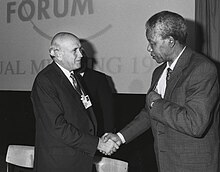
The Mahlabatini Declaration of Faith, signed by Mangosuthu Buthelezi and Harry Schwarz in 1974, enshrined the principles of peaceful transition of power and equality for all, the first of such agreements by black and white political leaders in South Africa. Ultimately, F.W. de Klerk opened bilateral discussions with Nelson Mandela in 1993 for a transition of policies and government.
In 1990, the National Party government took the first step towards dismantling discrimination when it lifted the ban on the ANC and other political organisations. It released Nelson Mandela from prison after 27 years of serving a sentence for sabotage. A negotiation process followed. With approval from the white electorate in a 1992 referendum, the government continued negotiations to end apartheid. South Africa held its first universal elections in 1994, which the ANC won by an overwhelming majority. It has been in power ever since. The country rejoined the Commonwealth of Nations and became a member of the Southern African Development Community.[90]
In post-apartheid South Africa, unemployment remained high. While many blacks have risen to middle or upper classes, the overall unemployment rate of black people worsened between 1994 and 2003 by official metrics but declined significantly using expanded definitions.[91] Poverty among whites, which was previously rare, increased.[92] The government struggled to achieve the monetary and fiscal discipline to ensure both redistribution of wealth and economic growth. The United Nations Human Development Index rose steadily until the mid-1990s[93] then fell from 1995 to 2005 before recovering its 1995 peak in 2013.[94] The fall is in large part attributable to the South African HIV/AIDS pandemic which saw South African life expectancy fall from a high point of 62 years in 1992 to a low of 53 in 2005,[95] and the failure of the government to take steps to address the pandemic in its early years.[96]
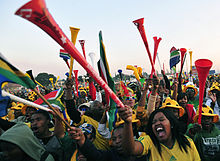

In May 2008, riots left over 60 people dead.[97] The Centre on Housing Rights and Evictions estimated that over 100,000 people were driven from their homes.[98] The targets were mainly legal and illegal migrants, and refugees seeking asylum, but a third of the victims were South African citizens.[97] In a 2006 survey, the South African Migration Project concluded that South Africans are more opposed to immigration than any other national group.[99] The UN High Commissioner for Refugees in 2008 reported over 200,000 refugees applied for asylum in South Africa, almost four times as many as the year before.[100] These people were mainly from Zimbabwe, though many also come from Burundi, Democratic Republic of the Congo, Rwanda, Eritrea, Ethiopia and Somalia.[100] Competition over jobs, business opportunities, public services and housing has led to tension between refugees and host communities.[100] While xenophobia in South Africa is still a problem, the United Nations High Commissioner for Refugees in 2011 reported that recent violence had not been as widespread as initially feared.[100] Nevertheless, as South Africa continues to grapple with racial issues, one of the proposed solutions has been to pass legislation, such as the pending Hate Crimes and Hate Speech Bill, to uphold South Africa's ban on racism and commitment to equality.[101][102]
On 14 February 2018, Jacob Zuma resigned the presidency. Since 15 February, ANC president Cyril Ramaphosa has been President of South Africa. On 16 March 2018, just over a month after President Jacob Zuma resigned from the presidency, National Director of Public Prosecutions Shaun Abrahams announced that Zuma would again face prosecution on 16 criminal charges – 12 charges of fraud, two of corruption, and one each of racketeering and money laundering, just as in the 2006 indictment. A warrant was issued for his arrest in February 2020 after he failed to appear in court. In 2021 he was found guilty of contempt of court and sentenced to 15 months' imprisonment. In response, supporters of Zuma engaged in protests which led to riots, looting, vandalism and widespread violence, leaving 354 people dead.[103]
South Africa has been undergoing a period of intense political and economic crisis since 2020 with growing numbers of international institutions, businesses and political figures warning that the country risks collapsing into a failed state due to high unemployment, low economic growth, low business investment, rising levels of violent crime, disorder, political corruption, and state capture.[104][105][106][107][108] The country been undergoing an energy crisis since 2007, resulting in routine rolling electricity blackouts due to loadshedding.[109] According to the International Monetary Fund, South Africa is suffering from "massive corruption" and state capture.[110]
The Zondo Commission, established in 2018 in order to investigate allegations of corruption and state capture released its findings in 2022. It found rampant corruption at every level of government, including Transnet, Eskom, and Denel, as well as law enforcement, intelligence agencies, and the civil service. It documented evidence of systemic corruption, fraud, racketeering, bribery, money laundering, and state capture. It investigated the African National Congress party and Jacob Zuma, whom it concluded were complicit in state capture through their direct assistance to the Gupta family.[111][112] "The Commission estimated the total amount of money spent by the state which was ‘tainted’ by state capture to be around R57 billion. More than 97% of the R57 billion came from Transnet and Eskom. Out of these funds, the Gupta enterprise received at least R15 billion. The total loss to the state is difficult to quantify, but would far exceed that R15 billion."[112]
South Africa has maintained a position of neutrality in regards to the Russia invasion of Ukraine in 2022 and the ongoing war. On 29 December 2023, South Africa formally submitted its case to the International Court of Justice regarding Israel's conduct in the Gaza Strip as part of the Israel–Hamas war, alleging that Israel had committed and was committing genocide against Palestinians in the Gaza Strip. South Africa has repeatedly hosted senior leaders of Hamas, the group responsible for the October 7th massacre in Israel.[113][114]
Following the 2024 general elections, the African National Congress saw its share of the national vote fall below 50% for the first time since the end of Apartheid, though it remained the single largest party in the South African Parliament.[115] President Ramaphosa called for a national unity government and has reportedly entered into negotiations with opposition parties in order to seek to form a coalition government, the first in South Africa's democratic history.[116][117]
Geography

South Africa is in southernmost Africa, with a coastline that stretches more than 2,500 km (1,553 mi) and along two oceans (the South Atlantic and the Indian). At 1,219,912 km2 (471,011 sq mi),[118] South Africa is the 24th-largest country in the world.[119] Excluding the Prince Edward Islands, the country lies between latitudes 22° and 35°S, and longitudes 16° and 33°E. The interior of South Africa consists of a large, in most places almost flat plateau with an altitude of between 1,000 m (3,300 ft) and 2,100 m (6,900 ft), highest in the east and sloping gently downwards towards the west and north, and slightly so to the south and south-west.[120] This plateau is surrounded by the Great Escarpment[121] whose eastern, and highest, stretch is known as the Drakensberg.[122] Mafadi in the Drakensberg at 3,450 m (11,320 ft) is the highest peak. The KwaZulu-Natal–Lesotho international border is formed by the highest portion of the Great Escarpment which reaches an altitude of over 3,000 m (9,800 ft).[123]
The south and south-western parts of the plateau (at approximately 1,100–1,800 m above sea level) and the adjoining plain below (at approximately 700–800 m above sea level – see map on the right) is known as the Great Karoo, which consists of sparsely populated shrubland. To the north, the Great Karoo fades into the more arid Bushmanland, which eventually becomes the Kalahari Desert in the north-west of the country. The mid-eastern and highest part of the plateau is known as the Highveld. This relatively well-watered area is home to a great proportion of the country's commercial farmlands and contains its largest conurbation (Gauteng). To the north of Highveld, from about the 25° 30' S line of latitude, the plateau slopes downwards into the Bushveld, which ultimately gives way to the Limpopo River lowlands or Lowveld.[121]
The coastal belt, below the Great Escarpment, moving clockwise from the northeast, consists of the Limpopo Lowveld, which merges into the Mpumalanga Lowveld, below the Mpumalanga Drakensberg (the eastern portion of the Great Escarpment).[124] This is hotter, drier and less intensely cultivated than the Highveld above the escarpment.[121] The Kruger National Park, located in the provinces of Limpopo and Mpumalanga in north-eastern South Africa, occupies a large portion of the Lowveld covering 19,633 square kilometres (7,580 sq mi)[125]
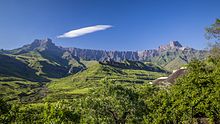

The coastal belt below the south and south-western stretches of the Great Escarpment contains several ranges of Cape Fold Mountains which run parallel to the coast, separating the Great Escarpment from the ocean.[126][127] (These parallel ranges of fold mountains are shown on the map, above left. Note the course of the Great Escarpment to the north of these mountain ranges.) The land between the Outeniqua and Langeberg ranges to the south and the Swartberg range to the north is known as the Little Karoo,[121] which consists of semi-desert shrubland similar to that of the Great Karoo, except that its northern strip along the foothills of the Swartberg Mountains has a somewhat higher rainfall and is, therefore, more cultivated than the Great Karoo. The Little Karoo is famous for its ostrich farming around Oudtshoorn. The lowland area to the north of the Swartberg range up to the Great Escarpment is the lowland part of the Great Karoo, which is climatically and botanically almost indistinguishable from the Karoo above the Great Escarpment. The narrow coastal strip between the Outeniqua and Langeberg ranges and the ocean has a moderately high year-round rainfall, which is known as the Garden Route. It is famous for the most extensive areas of forests in South Africa (a generally forest-poor country).
In the south-west corner of the country, the Cape Peninsula forms the southernmost tip of the coastal strip which borders the Atlantic Ocean and ultimately terminates at the country's border with Namibia at the Orange River. The Cape Peninsula has a Mediterranean climate, making it and its immediate surrounds the only portion of Sub-Saharan Africa which receives most of its rainfall in winter.[128][129] The coastal belt to the north of the Cape Peninsula is bounded on the west by the Atlantic Ocean and the first row of north–south running Cape Fold Mountains to the east. The Cape Fold Mountains peter out at about the 32° S line of latitude,[127] after which the Great Escarpment bounds the coastal plain. The most southerly portion of this coastal belt is known as the Swartland and Malmesbury Plain, which is an important wheat growing region, relying on winter rains. The region further north is known as Namaqualand,[130] which becomes more arid near the Orange River. The little rain that falls tends to fall in winter,[129] which results in one of the world's most spectacular displays of flowers carpeting huge stretches of veld in spring (August–September).
South Africa also has one offshore possession, the small sub-Antarctic archipelago of the Prince Edward Islands, consisting of Marion Island (290 km2 or 110 sq mi) and Prince Edward Island (45 km2 or 17 sq mi) (not to be confused with the Canadian province of the same name).
Climate

South Africa has a generally temperate climate because it is surrounded by the Atlantic and Indian Oceans on three sides, because it is located in the climatically milder Southern Hemisphere, and because its average elevation rises steadily toward the north (toward the equator) and further inland. This varied topography and oceanic influence result in a great variety of climatic zones. The climatic zones range from the extreme desert of the southern Namib in the farthest northwest to the lush subtropical climate in the east along the border with Mozambique and the Indian Ocean. Winters in South Africa occur between June and August. The extreme southwest has a climate similar to that of the Mediterranean with wet winters and hot, dry summers, hosting the famous fynbos biome of shrubland and thicket. This area produces much of the wine in South Africa and is known for its wind, which blows intermittently almost all year. The severity of this wind made passing around the Cape of Good Hope particularly treacherous for sailors, causing many shipwrecks. Further east on the south coast, rainfall is distributed more evenly throughout the year, producing a green landscape. The annual rainfall increases south of the Lowveld, especially near the coast, which is subtropical. The Free State is particularly flat because it lies centrally on the high plateau. North of the Vaal River, the Highveld becomes better watered and does not experience subtropical extremes of heat. Johannesburg, in the centre of the Highveld, is at 1,740 m (5,709 ft) above sea level and receives an annual rainfall of 760 mm (29.9 in). Winters in this region are cold, although snow is rare.[131]
The coldest place on mainland South Africa is Buffelsfontein in the Eastern Cape, where a temperature of −20.1 °C (−4.2 °F) was recorded in 2013.[132] The Prince Edward Islands have colder average annual temperatures, but Buffelsfontein has colder extremes. The deep interior of mainland South Africa has the hottest temperatures: a temperature of 51.7 °C (125.06 °F) was recorded in 1948 in the Northern Cape Kalahari near Upington,[133] but this temperature is unofficial and was not recorded with standard equipment; the official highest temperature is 48.8 °C (119.84 °F) at Vioolsdrif in January 1993.[134]
Climate change in South Africa is leading to increased temperatures and rainfall variability. Extreme weather events are becoming more prominent.[135] This is a critical concern for South Africans as climate change will affect the overall status and wellbeing of the country, for example with regards to water resources. Speedy environmental changes are resulting in clear effects on the community and environmental level in different ways and aspects, starting with air quality, to temperature and weather patterns, reaching out to food security and disease burden.[136] According to computer-generated climate modelling produced by the South African National Biodiversity Institute,[137] parts of southern Africa will see an increase in temperature by about 1 °C (1.8 °F) along the coast to more than 4 °C (7.2 °F) in the already hot hinterland such as the Northern Cape in late spring and summertime by 2050. The Cape Floral Region is predicted to be hit very hard by climate change. Drought, increased intensity and frequency of fire, and climbing temperatures are expected to push many rare species towards extinction. South Africa has published two national climate change reports in 2011 and 2016.[138] South Africa contributes considerable carbon dioxide emissions, being the 14th largest emitter of carbon dioxide,[139] primarily from its heavy reliance on coal and oil for energy production.[139] As part of its international commitments, South Africa has pledged to peak emissions between 2020 and 2025.[139]
Biodiversity


South Africa signed the Rio Convention on Biological Diversity on 4 June 1994 and became a party to the convention on 2 November 1995.[140] It has subsequently produced a National Biodiversity Strategy and Action Plan, which was received by the convention on 7 June 2006.[141] The country is ranked sixth out of the world's seventeen megadiverse countries.[142] Ecotourism in South Africa has become more prevalent in recent years, as a possible method of maintaining and improving biodiversity.
Numerous mammals are found in the Bushveld including lions, African leopards, South African cheetahs, southern white rhinos, blue wildebeest, kudus, impalas, hyenas, hippopotamuses and South African giraffes. A significant extent of the Bushveld exists in the north-east including Kruger National Park and the Sabi Sand Game Reserve, as well as in the far north in the Waterberg Biosphere. South Africa houses many endemic species, among them the critically endangered riverine rabbit (Bunolagus monticullaris) in the Karoo.
Up to 1945, more than 4,900 species of fungi (including lichen-forming species) had been recorded.[143] In 2006, the number of fungi in South Africa was estimated at 200,000 species but did not take into account fungi associated with insects.[144] If correct, then the number of South African fungi dwarfs that of its plants. In at least some major South African ecosystems, an exceptionally high percentage of fungi are highly specific in terms of the plants with which they occur.[145] The country's Biodiversity Strategy and Action Plan does not mention fungi (including lichen-forming fungi).[141]
With more than 22,000 different vascular plants, or about 9% of all the known species of plants on Earth,[146] South Africa is particularly rich in plant diversity. The most prevalent biome is the grassland, particularly on the Highveld, where the plant cover is dominated by different grasses, low shrubs, and acacia, mainly camel-thorn (Vachellia erioloba). Vegetation is sparse towards the north-west because of low rainfall. There are numerous species of water-storing succulents, like aloes and euphorbias, in the very hot and dry Namaqualand area. And according to the World Wildlife Fund, South Africa is home to around a third of all succulent species.[147] The grass and thorn savanna turns slowly into a bush savanna towards the north-east of the country, with denser growth. There are significant numbers of baobab trees in this area, near the northern end of Kruger National Park.[148]
The fynbos biome, which makes up the majority of the area and plant life in the Cape Floristic Region, is located in a small region of the Western Cape and contains more than 9,000 of those species, or three times more plant species than found in the Amazon rainforest,[149] making it among the richest regions on earth in terms of plant diversity. Most of the plants are evergreen hard-leaf plants with fine, needle-like leaves, such as the sclerophyllous plants. Another uniquely South African flowering plant group is the genus Protea, with around 130 different species. While South Africa has a great wealth of flowering plants, only 1% of the land is forest, almost exclusively in the humid coastal plain of KwaZulu-Natal, where there are also areas of Southern Africa mangroves in river mouths. Even smaller reserves of forests are out of the reach of fire, known as montane forests. Plantations of imported tree species are predominant, particularly the non-native eucalyptus and pine.

South Africa has lost a large area of natural habitat in the last four decades, primarily because of overpopulation, sprawling development patterns, and deforestation during the 19th century. The country had a 2019 Forest Landscape Integrity Index mean score of 4.94/10, ranking it 112th globally out of 172 countries.[150] South Africa is one of the worst affected countries in the world when it comes to invasion by alien species with many (e.g., black wattle, Port Jackson willow, Hakea, Lantana and Jacaranda) posing a significant threat to the native biodiversity and the already scarce water resources. Also woody plant encroachment of native plants in grasslands poses a threat to biodiversity and related ecosystem services, affecting over 7 million hectares.[151] The original temperate forest found by the first European settlers was exploited until only small patches remained. Currently, South African hardwood trees like real yellowwood (Podocarpus latifolius), stinkwood (Ocotea bullata), and South African black ironwood (Olea capensis) are under strict government protection. Statistics from the Department of Environmental Affairs show a record 1,215 rhinos were killed in 2014.[152] Since South Africa is home to a third of all succulent species (many endemic to the Karoo), it makes it a hotspot for plant poaching, leading to many species to be threatened with extinction.[147]
Demographics

- <1 /km2
- 1–3 /km2
- 3–10 /km2
- 10–30 /km2
- 30–100 /km2
- 100–300 /km2
- 300–1000 /km2
- 1000–3000 /km2
- >3000 /km2
South Africa is a nation of about 62 million (as of 2022) people of diverse origins, cultures, languages, and religions.[153] The last census was held in 2022, with estimates produced on an annual basis. According to the United Nations' World Population Prospects, South Africa's total population was 55.3 million in 2015, compared to only 13.6 million in 1950.[154] South Africa is home to an estimated five million illegal immigrants, including some three million Zimbabweans.[155][156][157] A series of anti-immigrant riots occurred beginning in May 2008.[158][159]
Statistics South Africa asks people to describe themselves in the census in terms of five racial population groups.[160] The 2022 census figures for these groups were: Black African at 81%, Coloured at 8.2%, White at 7.3%, Indian or Asian at 2.7%, and Other/Unspecified at 0.5%.[161] The first census in 1911 showed that whites made up 22% of the population; this had declined to 16% by 1980.[162]
South Africa hosts a sizeable refugee and asylum seeker population. According to the World Refugee Survey 2008, published by the U.S. Committee for Refugees and Immigrants, this population numbered approximately 144,700 in 2007.[163] Groups of refugees and asylum seekers numbering over 10,000 included people from Zimbabwe (48,400), the DRC (24,800), and Somalia (12,900).[163] These populations mainly lived in Johannesburg, Pretoria, Durban, Cape Town, and Port Elizabeth.[163]
Languages
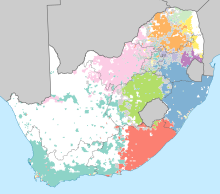
South Africa has 12 official languages:[4] Zulu, Xhosa, Afrikaans, English, Pedi,[164] Tswana, Southern Sotho, Tsonga, Swazi, Venda, and Southern Ndebele (in order of first language speakers), as well as South African Sign Language which was recognised as an official language in 2023.[4]In this regard it is fourth only to Bolivia, India, and Zimbabwe in number. While all the languages are formally equal, some languages are spoken more than others. According to the 2022 census, the three most spoken first languages are Zulu (24.4%), Xhosa (16.6%), and Afrikaans (10.6%).[161] Although English is recognised as the language of commerce and science, it is only the fifth most common home language, that of only 8.7% of South Africans in 2022; nevertheless, it has become the de facto lingua franca of the nation.[161] Estimates based on the 1991 census suggest just under half of South Africans could speak English.[165] It is the second most commonly spoken language outside of the household, after Zulu.[166]
Other languages are spoken, or were widely used previously, including Fanagalo, Khoe, Lobedu, Nama, Northern Ndebele, and Phuthi.[167] Many of the unofficial languages of the San and Khoekhoe peoples contain regional dialects stretching northwards into Namibia and Botswana, and elsewhere. These people, who are a physically distinct population from the Bantu people who make up most of the Black Africans in South Africa, have their own cultural identity based on their hunter-gatherer societies. They have been marginalised, and the remainder of their languages are in danger of becoming extinct.
White South Africans may also speak European languages, including Italian, Portuguese (also spoken by black Angolans and Mozambicans), Dutch, German, and Greek, while some Indian South Africans and more recent migrants from South Asia speak Indian languages, such as Gujarati, Hindi, Tamil, Telugu, and Urdu. French is spoken by migrants from Francophone Africa.
Religion
According to the 2001 census, Christians accounted for 79.8% of the population, with a majority of them being members of various Protestant denominations (broadly defined to include syncretic African-initiated churches) and a minority of Roman Catholics and other Christians. Christian category includes Zion Christian (11.1%), Pentecostal (Charismatic) (8.2%), Roman Catholic (7.1%), Methodist (6.8%), Dutch Reformed (6.7%), and Anglican (3.8%). Members of remaining Christian churches accounted for another 36% of the population. Muslims accounted for 1.5% of the population, Hindus 1.2%,[169] traditional African religions 0.3% and Judaism 0.2%. 15.1% had no religious affiliation, 0.6% were "other" and 1.4% were "unspecified."[170][169][171][172]
African-initiated churches formed the largest of the Christian groups. It was believed that many of the persons who claimed no affiliation with any organised religion adhered to a traditional African religion. There are an estimated 200,000 traditional healers, and up to 60% of South Africans consult these healers,[173] generally called sangoma ('diviner') or inyanga ('herbalist'). These healers use a combination of ancestral spiritual beliefs and a belief in the spiritual and medicinal properties of local fauna, flora, and funga commonly known as muti ('medicine'), to facilitate healing in clients. Many peoples have syncretic religious practices combining Christian and indigenous influences.[174]
South African Muslims comprise mainly Coloureds and Indians. They have been joined by black or white South African converts as well as those from other parts of Africa.[175] South African Muslims describe their faith as the fastest-growing religion of conversion in the country, with the number of black Muslims growing sixfold, from 12,000 in 1991 to 74,700 in 2004.[175][176]
There is a substantial Jewish population, descended from European Jews who arrived as a minority among other European settlers. This population peaked in the 1970s at 118,000, though only around 75,000 remain today, the rest having emigrated, mostly to Israel.[177] Even so, these numbers make the Jewish community in South Africa the twelfth largest in the world.
Education

The adult literacy rate in 2007 was 89%.[178] South Africa has a three-tier system of education starting with primary school, followed by high school, and tertiary education in the form of (academic) universities and universities of technology. Learners have twelve years of formal schooling, from grade 1 to 12. Grade R, or grade 0, is a pre-primary foundation year.[179] Primary schools span the first seven years of schooling.[180] High school education spans a further five years. The National Senior Certificate examination takes place at the end of grade 12 and is necessary for tertiary studies at a South African university.[179] Public universities are divided into three types: traditional universities, which offer theoretically oriented university degrees; universities of technology (formerly called technikons), which offer vocationally-oriented diplomas and degrees; and comprehensive universities, which offer both types of qualification. There are 23 public universities in South Africa: 11 traditional universities, 6 universities of technology, and 6 comprehensive universities.
Under apartheid, schools for black people were subject to discrimination through inadequate funding and a separate syllabus called Bantu Education which only taught skills sufficient to work as labourers.[181]
In 2004, South Africa started reforming its tertiary education system, merging and incorporating small universities into larger institutions, and renaming all tertiary education institutions "university". By 2015, 1.4 million students in higher education have been aided by a financial aid scheme which was promulgated in 1999.[182]
Health
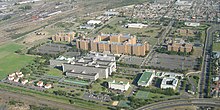
According to the South African Institute of Race Relations, the life expectancy in 2009 was 71 years for a white South African and 48 years for a black South African.[183] The healthcare spending in the country is about 9% of GDP.[184] About 84% of the population depends on the public healthcare system,[184] which is beset with chronic human resource shortages and limited resources.[185] About 20% of the population use private healthcare.[186] Only 16% of the population are covered by medical aid schemes;[187] the rest pay for private care out-of-pocket or through in-hospital-only plans.[186] The three dominant hospital groups, Mediclinic, Life Healthcare and Netcare, together control 75% of the private hospital market.[186]
HIV/AIDS

According to the 2015 UNAIDS medical report, South Africa has an estimated seven million people who are living with HIV – more than any other country in the world.[188] In 2018, HIV prevalence—the percentage of people living with HIV—among adults (15–49 years) was 20.4%, and in the same year 71,000 people died from an AIDS-related illness.[189]
A 2008 study revealed that HIV/AIDS infection is distinctly divided along racial lines: 13.6% of blacks are HIV-positive, whereas only 0.3% of whites have the virus.[190] Most deaths are experienced by economically active individuals, resulting in many AIDS orphans who in many cases depend on the state for care and financial support.[191] It is estimated that there are 1,200,000 orphans in South Africa.[191]
The link between HIV, a virus spread primarily by sexual contact, and AIDS was long denied by President Thabo Mbeki and his health minister Manto Tshabalala-Msimang, who insisted that the many deaths in the country are caused by malnutrition, and hence poverty, and not HIV.[192] In 2007, in response to international pressure, the government made efforts to fight AIDS.[193] After the 2009 general elections, President Jacob Zuma appointed Aaron Motsoaledi as the health minister and committed his government to increasing funding for and widening the scope of HIV treatment,[194] and by 2015, South Africa had made significant progress, with the widespread availability of antiretroviral drugs resulted in an increase in life expectancy from 52.1 years to 62.5 years.[195]
Urbanization
One online database[196] lists South Africa having more than 12,600 cities and towns. The following are the largest cities and towns in South Africa.



